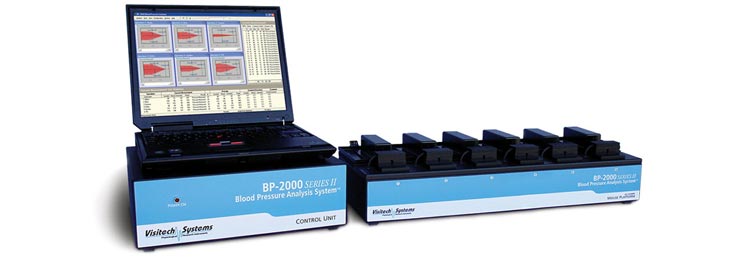
BP-2000
The BP-2000 Blood Pressure Analysis System™ is the world's leading non-invasive blood pressure analyzer for mice and rats. Its proven technology is now depended on in hundreds of laboratories around the world. More than 500 research papers have been published using the BP-2000.
The BP-2000 Blood Pressure Analysis System was developed for Dr. Oliver Smithies (2007 Nobel Prize in Medicine), to allow him to measure the blood pressure of his groundbreaking transgenic mouse models.
A variety of models for both mice and rats are available to meet every research need.
Advantages
- The BP-2000 is the world's most widely used system for non-invasively measuring mouse blood pressure.
- More than 500 research papers have been published using the BP-2000. On average, about one paper a week is published with the BP-2000!
- Highly accurate. The BP-2000 gives results that correlate closely with interarterial measurements (Krege JH, Hodgin JB, Hagaman JR, Smithies O, Hypertension. 1995; 25: 1111-1115).
- Jackson Laboratories, the world's largest supplier of laboratory mice, has a large number of BP-2000 systems that they are currently using for measuring mouse blood pressure.
- Charles River Laboratories, the world's largest supplier of laboratory rats, uses the BP-2000 to establish baseline BP values for their hypertensive rat models. The BP-2000 was featured in their Outlook newsletter from Spring, 2006.
Features
- Measures systolic and diastolic blood pressure, and heart rate. Calculates mean blood pressure.
- Many models for mice and rats. Models are available for two, four, or six mice; and for two, four, or six rats. Combined mouse and rat systems are also available.
- Easily expand your system by adding additional channels (maximum of six), or add ability to measure both rats and mice - at a fraction of the cost of buying another system.
- A large range of animals restrainers: 4 sizes for mice, and 6 for rats. Our specially designed restrainers hold the animals comfortably, and allow them to breathe freely.
- Automatic temperature control gently warms the animals.
- Works well with both conscious and anesthetized animals.
- Optionally includes a notebook computer. If you provide your own computer, it is easy to download and install the BP-2000 Analysis Software.
- Intuitive and powerful software. The BP-2000 Analysis Software displays, measures, and stores blood pressure, heart rate, and waveforms in its built-in database. Your data – including waveforms – can be easily reviewed.
- Free lifetime upgrades to the BP-2000 Analysis Software.
How it Works
The BP-2000 uses transmission photoplethysmography, in which variations in the amount of light transmitted through the tail is the basic signal that is analyzed to determine the blood pressure and pulse rate.
Every time the heart beats, a pressure wave travels through the vascular system. When it reaches the tail, the vessels dilate slightly, and thus scatter more red light. (This corresponds to systole.) As the pressure wave passes, the vessels in the tail get smaller as the pressure decreases, and less light is scattered. (This corresponds to diastole.) The variation in light transmitted through the tail is what the BP-2000 displays on the computer screen.
Photoplethysmography is very effective at measuring blood pressure on animals ranging from small mice to extremely large rats. And unlike approaches that use a additional sensing cuff (or volume-pressure cuff), photoplethysmography works more reliably with small mouse tails (and does not require two cuffs on the tail).
The diastolic and systolic pressure can be determined by monitoring the vessel dilation as the occlusion cuffs inflates. Here is a plot of actual data showing where diastolic and systolic are measured:

How does it work? Here are two explanations, with progressively more detail:
Simplest Explanation
- Where the waveform amplitude (height) starts to decrease is the diastolic pressure.
- Where the waveform amplitude decreases to and remains at a steady value is the systolic pressure.
More Complicated Explanation
When the BP-2000 software has determined the pulse rate, it starts inflating the occlusion cuff. When the occlusion pressure reaches the diastolic pressure, the amplitude of the waveform starts to decrease, since the vessels cannot dilate as much in response to the heartbeat. When the occlusion pressure equals the systolic pressure, the waveform remains at a steady value and thereafter does not decrease, since the vessels cannot dilate at all.
The BP-2000 has been shown in peer-reviewed literature to closely correlate with direct interarterial measurements (Krege JH, Hodgin JB, Hagaman JR, Smithies O, Hypertension. 1995; 25: 1111-1115).
The BP-2000 Analysis Software is the most advanced BP analysis software available. It is easy to use, yet provides all the power you need to make accurate measurements, review and verify your data, and export your results.
